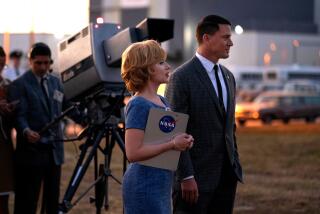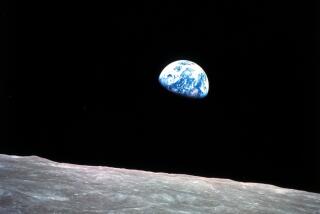Apollo Flights Send Producer on a Mission : Movies: Al Reinert uses footage from nine Apollo moon voyages to create ‘For All Mankind.’
- Share via
Ten years ago, Texas magazine writer Al Reinert made a trip to the Johnson Space Center in Houston to research an article commemorating the 10th anniversary of man’s landing on the moon. Until then, he had not followed America’s space program with unusual interest and certainly could not have foreseen that his sojourn inside the vaults of the NASA archives would eventually uproot him from his familiar free-lance writer’s desk and hurl him into the quixotic role of independent film maker.
But that is what happened, as is now evident from the release of Reinert’s decade-in-the-making documentary about the moon missions, “For All Mankind,” now playing a limited engagement at the Cinerama Dome, Crest in Westwood, and other selected theaters.
The feature-length film he made is a brand of poetic nonfiction. The voices of 13 astronauts narrate a composite voyage to the moon, assembled from rarely seen NASA footage taken during the nine manned Apollo flights and underscored by the quietly ethereal guitar lines of art rock composer Brian Eno.
Like fellow journalist Michael Moore, who made the recent movie “Roger & Me,” Reinert had no previous experience in motion pictures when he began his film odyssey in 1979. Initially, he was armed only with $30,000 raised from friends and the knowledge that most of the film shot by NASA during the historic Apollo missions was technically in the public domain. The biggest problem was, there were 2,000 hours of it.
“Anybody can walk into the NASA film archives and do film research,” Reinert said during a visit to Los Angeles, where the film opens today. “I was just the first fool who said, ‘I want to see all of it.’ ”
Reinert moved to Houston, where for two years he sat down almost every day with a NASA film librarian to look at film of the Apollo flights. Eventually, he logged more time there than all three television networks combined.
“It was the first time I had an awareness of it as film instead of just boring TV stuff. I thought, ‘Why has this never been on a big screen?’ It was my naive writer’s reaction to it. I mean, I wasn’t a film maker, but I thought, this is a movie that I would like to see.”
He had arrived at a good time. The Apollo program was finished and the first space shuttle launch was still a few years away. “All these people at NASA had nothing better to do than sit around and tell you their stories. That’s when I met the first astronauts I’d ever met. Most of them were retired even then, and so they no longer had NASA looking over their shoulders. And as individuals they had had time for the experience to have settled and percolated a bit.”
Reinert talked to all 24 men who had flown to the moon and recorded 80 hours of interviews with 20 of them. The interviews revealed something surprising that would shape the movie: the experience the astronauts remembered most vividly was not going to the moon but leaving the Earth.
“Apollo had always been portrayed as going to the moon. It never occurred to me that that’s really secondary,” Reinert said. “The moon’s just the first place you can stop. But what was really meaningful to these guys, if you talk to them, what sticks in their minds was leaving the Earth . . . because for days they watched the Earth shrink!
“What I heard from all these men was the story of a spiritual journey, much more than a technical achievement.”
Reinert made the decision early on to “scramble all the missions together,” in order to create a single representative trip in the narrative. He said the astronauts themselves encouraged him to do this.
“My attitude is that it’s historical trivia that there were nine different missions. Most people aren’t even aware of that after only 20 years. The story we tried to tell from the beginning was a subjective story--what was it like to leave Earth? It’s not about the space program, it’s not about NASA.”
NASA is not even mentioned in the film.
“What we were trying to do from Day One was make the movie that people would watch in 500 years when they want to know about this. Had there been a camera crew with Columbus, we’d still watch that movie and that was 500 years ago.”
Each of the Apollo missions carried at least three movie cameras aboard for the astronauts to use, as well as cameras mounted inside the stages of the rocket to capture close-up pictures of a separation 70 miles above the Earth.
“For All Mankind” also includes such exotica as platform-level footage of a blast-off taken by a camera that was melted in the process and startling moonscapes of astronauts hopping up and down in song like boys on a playground.
These are images most Americans have never seen before, but such originality was not enough to get the movie made or distributed in less than 10 years. Reinert, 42, used up his initial investment to make a 10-minute sample to show investors, but it wasn’t long before he was back looking for magazine assignments to pay his bills.
“We showed that 10 minutes to whoever would look at it and raised the next bunch of money, about $75,000, and went back to work,” he said. “That’s been the history of the whole project.”
Eventually, a limited partnership was put together and $600,000 was raised. In all, Reinert and co-producer Betsy Broyles Breier tapped 40 Texas investors to cover the film’s $1.5 million budget.
“We were not great fund-raisers,” Reinert said. “It took us two years to sell 17 partnership units of $33,000 each. We’re not talking Donald Trump here.”
But Reinert, a bearish, garrulous Texan, was not without the gift of persuasion. Back in 1983, when he was still editing parts of the rough cut in his Houston living room and listening to assorted records in search of a suitable sound track, he sent off a six-page letter to Brian Eno asking for his help.
Two months later Eno booked six weeks of studio time with his own money to score the film. “He hasn’t been paid anything yet,” the director said.
“For All Mankind” was finished a year ago and shown for the first time at the U.S. Film Festival in Park City, Utah, where it won the grand jury prize for best documentary. It has gone on to showings at festivals in Tokyo, Munich, Montreal, Toronto and last week Palm Springs, earning support along the way from George Lucas, Robert Redford and the Sierra Club, Earthwatch and other environmental groups.
But it has not found a Hollywood distributor.
In November, Reinert and executive producer Fred Miller decided to go directly to theater owners, essentially booking the film themselves into five theaters in San Francisco and Seattle “to see if we were right or not, or if we were complete fools.”
The film did more than $200,000 worth of business in four weeks, which led to later bookings in Los Angeles, Texas and, next month, the East Coast.
“Off and on I think the most I ever got paid was $600 a week,” Reinert recalled of his decade-long film labors. “And I got that sporadically. But mostly I paid the bills as a magazine writer. I had a lot more money 10 years ago than I have now.”
More to Read
Only good movies
Get the Indie Focus newsletter, Mark Olsen's weekly guide to the world of cinema.
You may occasionally receive promotional content from the Los Angeles Times.










